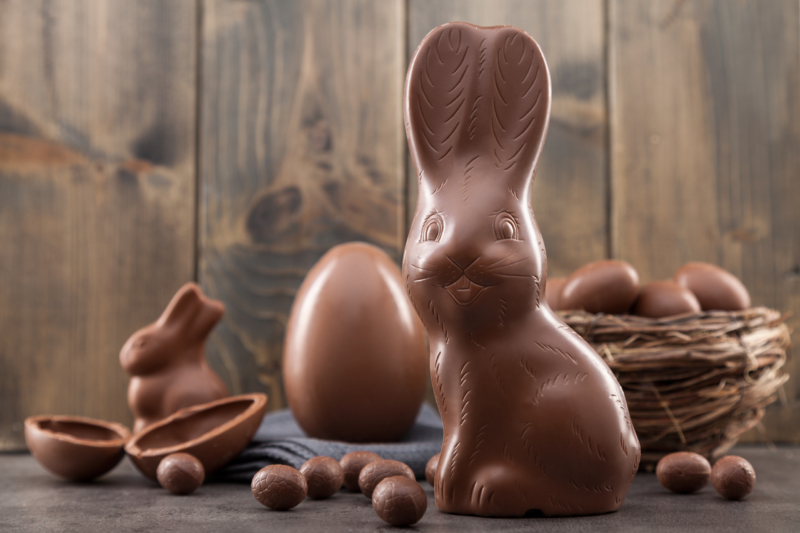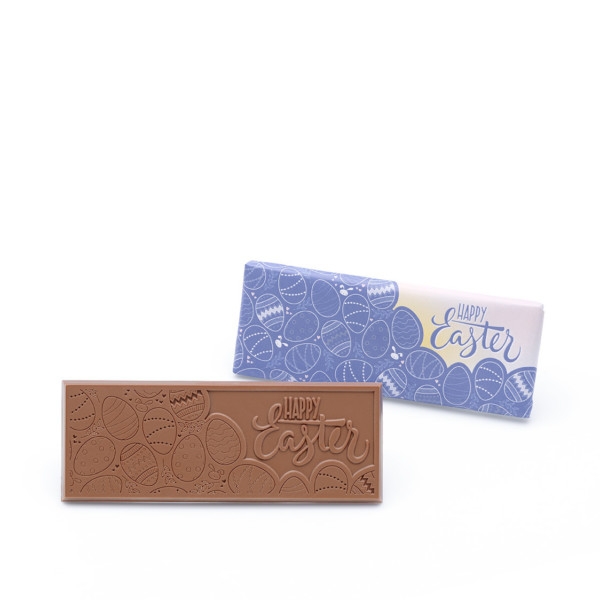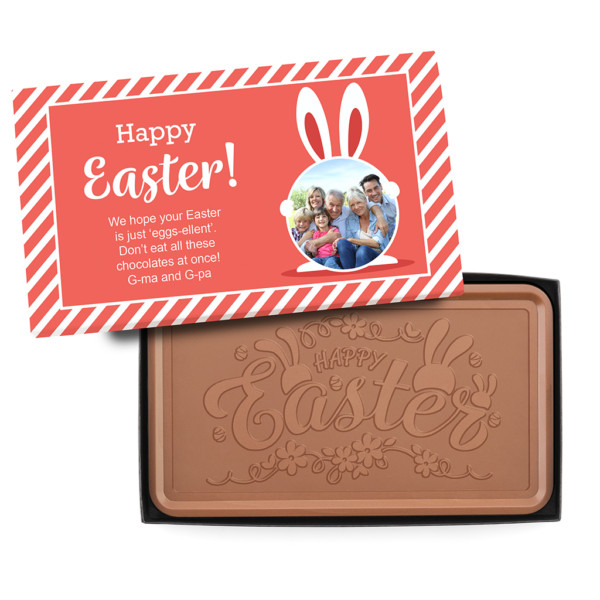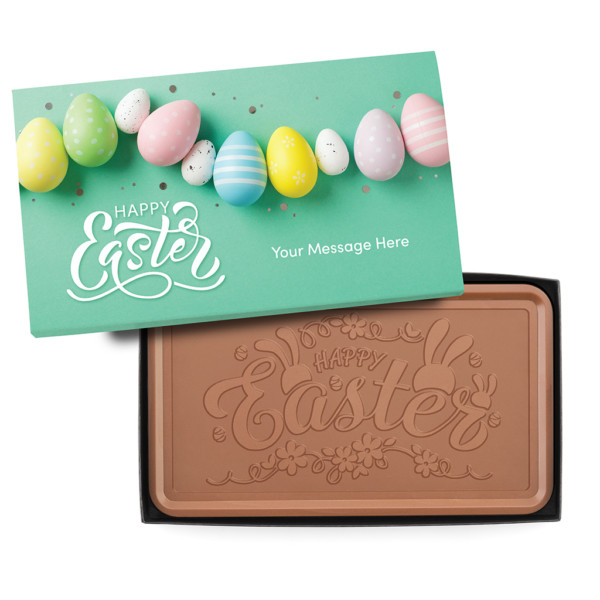We all likely know that Easter is a Catholic holiday – the culmination of the story of Jesus’ crucifixion and resurrection – and yet, so many Easter traditions that we are used to seeing every year have little to do with anything biblical at all.
Specifically, we’re talking about chocolate eggs and chocolate bunnies. Where did these come from and why are they now such an integral part of this holiday? The answer is actually pretty complicated. Like many things in the modern world, current Easter traditions are a combination of religion, marketing, paganism and a love for candy and chocolate!
So yes, it is complex, but this article will try to answer the burning question: Why do we eat chocolate eggs and bunnies at Easter?
How Did Chocolate Become Associated With Easter?
Chocolate only became commonplace sometime in the mid-1800s, so relatively speaking, it is a fairly recent addition to the holiday. And though we eat both chocolate eggs and chocolate bunnies at Easter, they have evolved along two separate paths before eventually meeting. Like we said, it’s a strange story! But we’ll get there.
Let’s take a look at chocolate bunnies first.
Chocolate bunnies: A symbol of fertility and spring
Neither rabbits, hares, nor bunnies are mentioned in biblical scriptures, including the parts that tell the story of Jesus’ final days. Instead, their appearance is more pagan in nature.
While we know that Easter is rooted in religion, the other quality of Easter that most of us are familiar with is that it aligns with spring.
What else do we normally associate with spring? That’s right… fertility! Do you know what else represents fertility? You got it. Rabbits. And here’s where the blend of paganism and other folklore begin to blend in.
The role of Ostara in Easter traditions
In German folklore, the goddess of fertility was called Ostara, and she was often symbolized with a hare at her side. Ostara sounds a lot like Easter. In fact, the word Easter was derived from her name. Every April, a celebration was thrown in honour of Ostara, and would include plenty of rabbit symbolism. Interesting, right? Now we’re getting somewhere.
But let’s put a pin in this for a minute. Don’t worry, we will come back to it.
Easter eggs: A mix of Christian and folk traditions
While rabbits have purely pagan origins, Easter eggs, on the other hand, have a little more connection to biblical origins. Orthodox or traditional Easter meals are heavy in symbolism—each dish is connected to an element of the Christ story. There is also an element of fasting and giving things up (if you are familiar with Lent). And eating certain things, like eggs, was originally not allowed by church officials during Holy Week (the week leading up to Easter).
This was at a time when eggs were laid locally and so any that were produced during Holy Week were saved and then handed out to children as gifts. Sounds like a crummy gift to us nowadays but maybe they loved it? We can’t be sure. But this is an element of the egg’s journey to Easter.
The connection between eggs and the Easter bunny
German immigrants brought their culture and heritage to America. Remember that Ostara was a German goddess? The Pennsylvania Dutch (who are of German descent) also imported the Oschter Haws, or Easter Hare, who delivered colored eggs to good children.
Now, it’s all starting to come together. Rabbits, spring, eggs–all coinciding with the celebration of Easter. Over time, these elements became completely intertwined, creating the traditions we know today.

Where Does Chocolate Fit In?
As mentioned, chocolate wasn’t widely available before the middle of the 19th century. Until then, chocolate was expensive, complicated to make and made in small batches. And it was often served as a liquid–certainly not in either egg or rabbit form.
Industrialization and the mass production of chocolate
As the Industrial Revolution took hold, manufacturing began to apply to and change industries across the board. This included food and chocolate manufacturing. Integrating mechanization into the chocolate-making process changed the scope by which chocolate could be made and distributed. It became cheaper and more accessible.
Mold-making also became more complex and widely available. Maybe it’s no surprise that Germany became a hotspot of mold making, and a man named Anton Reiche was one of the best-known manufacturers. He created an array of tinplate molds for chocolate, which began reaching countries around the world.
You can probably see where this exciting tale is going. While the Easter symbolism we are familiar with today (rabbits, eggs, etc.) had been around for a while, it was about to meet up with the last sweet element.
The first large chocolate bunny display
In 1890, a Pennsylvania man named Robert L. Strohecker (a distinctly German name) created a five-foot chocolate rabbit. He put it up in his drugstore at Easter to attract sightseers and boost business. This might be one of the first examples of Easter chocolate marketing, though there isn’t a definitive source to confirm it.
But the idea started to spread, and evidence of it begins to appear more frequently in historical records. For example, a photo from 1927 shows two young boys standing on either side of a 75-pound chocolate rabbit in front of Florian’s Pharmacy in St. Paul, Minnesota.
The modern Easter chocolate tradition
The rest is history! Chocolate eggs and chocolate bunnies, as well as Jesus on the cross, the resurrection, and spring itself, all share in this one mash-up of a holiday. It’s a little bizarre, but that’s the world today–one big melting pot.
Some of the most famous Easter chocolate traditions include:
- Chocolate eggs and bunnies are enjoyed worldwide, with various cultures putting their own spin on Easter confections.
- Handcrafted chocolate eggs filled with pralines or small surprises are a common Easter delicacy in many countries.
- Custom-made Easter chocolates, like the ones we create at Totally Chocolate, bring a personal touch to holiday celebrations.
Final Thoughts: Why Do We Eat Chocolate at Easter?
Chocolate eggs and chocolate bunnies, the resurrection of Jesus, and the arrival of spring have all merged into one unique Easter tradition.
Whatever your take on the holiday is, we hope you get a chance to enjoy some delicious chocolate.
The tradition of eating chocolate eggs and bunnies at Easter is a fascinating mix of ancient pagan rituals, Christian symbolism, industrial innovation, and modern marketing. What began as separate traditions–eggs symbolizing renewal, rabbits representing fertility, and chocolate as a luxurious treat–eventually merged into a beloved Easter tradition worldwide.
Whether you celebrate Easter for religious reasons, cultural traditions, or simply for the love of chocolate, one thing is certain–Easter wouldn’t be the same without these sweet treats!
Discover 10 unique personalized Easter chocolate gift ideas perfect for business, family, & friends.
Buy Easter Chocolate Online
At Totally Chocolate, we believe that Easter is the perfect time to indulge in high-quality, custom chocolate creations. Whether you’re gifting a loved one or treating yourself, our handcrafted chocolates bring an extra layer of joy to your Easter celebrations.
Happy Easter, and enjoy your chocolate!




